Abhimanyu Dubey
Jack
The Llama 3 Herd of Models
Jul 31, 2024Abstract:Modern artificial intelligence (AI) systems are powered by foundation models. This paper presents a new set of foundation models, called Llama 3. It is a herd of language models that natively support multilinguality, coding, reasoning, and tool usage. Our largest model is a dense Transformer with 405B parameters and a context window of up to 128K tokens. This paper presents an extensive empirical evaluation of Llama 3. We find that Llama 3 delivers comparable quality to leading language models such as GPT-4 on a plethora of tasks. We publicly release Llama 3, including pre-trained and post-trained versions of the 405B parameter language model and our Llama Guard 3 model for input and output safety. The paper also presents the results of experiments in which we integrate image, video, and speech capabilities into Llama 3 via a compositional approach. We observe this approach performs competitively with the state-of-the-art on image, video, and speech recognition tasks. The resulting models are not yet being broadly released as they are still under development.
Context Diffusion: In-Context Aware Image Generation
Dec 06, 2023Abstract:We propose Context Diffusion, a diffusion-based framework that enables image generation models to learn from visual examples presented in context. Recent work tackles such in-context learning for image generation, where a query image is provided alongside context examples and text prompts. However, the quality and fidelity of the generated images deteriorate when the prompt is not present, demonstrating that these models are unable to truly learn from the visual context. To address this, we propose a novel framework that separates the encoding of the visual context and preserving the structure of the query images. This results in the ability to learn from the visual context and text prompts, but also from either one of them. Furthermore, we enable our model to handle few-shot settings, to effectively address diverse in-context learning scenarios. Our experiments and user study demonstrate that Context Diffusion excels in both in-domain and out-of-domain tasks, resulting in an overall enhancement in image quality and fidelity compared to counterpart models.
Emu: Enhancing Image Generation Models Using Photogenic Needles in a Haystack
Sep 27, 2023



Abstract:Training text-to-image models with web scale image-text pairs enables the generation of a wide range of visual concepts from text. However, these pre-trained models often face challenges when it comes to generating highly aesthetic images. This creates the need for aesthetic alignment post pre-training. In this paper, we propose quality-tuning to effectively guide a pre-trained model to exclusively generate highly visually appealing images, while maintaining generality across visual concepts. Our key insight is that supervised fine-tuning with a set of surprisingly small but extremely visually appealing images can significantly improve the generation quality. We pre-train a latent diffusion model on $1.1$ billion image-text pairs and fine-tune it with only a few thousand carefully selected high-quality images. The resulting model, Emu, achieves a win rate of $82.9\%$ compared with its pre-trained only counterpart. Compared to the state-of-the-art SDXLv1.0, Emu is preferred $68.4\%$ and $71.3\%$ of the time on visual appeal on the standard PartiPrompts and our Open User Input benchmark based on the real-world usage of text-to-image models. In addition, we show that quality-tuning is a generic approach that is also effective for other architectures, including pixel diffusion and masked generative transformer models.
COLA: How to adapt vision-language models to Compose Objects Localized with Attributes?
May 05, 2023Abstract:Compositional reasoning is a hallmark of human visual intelligence; yet despite the size of large vision-language models, they struggle to represent simple compositions by combining objects with their attributes. To measure this lack of compositional capability, we design Cola, a text-to-image retrieval benchmark to Compose Objects Localized with Attributes. Using Cola as a testbed, we explore modeling designs to adapt pre-trained vision-language models to reason compositionally about multiple attributes attached to multiple objects. We explore 6 finetuning strategies on 2 seminal vision-language models, using 3 finetuning datasets and 2 test benchmarks (Cola and CREPE). Surprisingly, our optimal finetuning strategy improves a 151M parameter CLIP, which disjointly encodes image and language during pretraining, to perform as well as a 241M parameter FLAVA, which uses a multi-modal transformer encoder during pretraining to attend over both vision and language modalities. This optimal finetuning strategy is a lightweight multi-modal adapter that jointly attends over both image and language features generated by the pretrained model. We show this works better than common strategies such as prompt/fine-tuning, or tuning a comparable number of unimodal layers.
Filtering, Distillation, and Hard Negatives for Vision-Language Pre-Training
Jan 05, 2023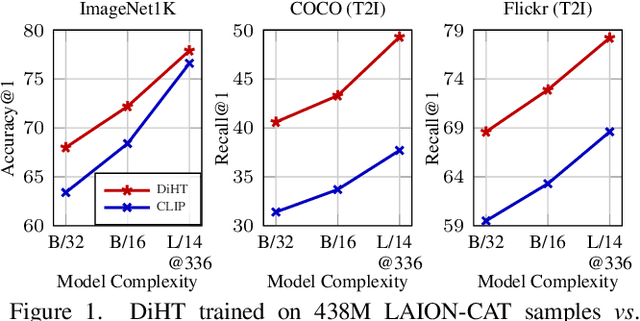
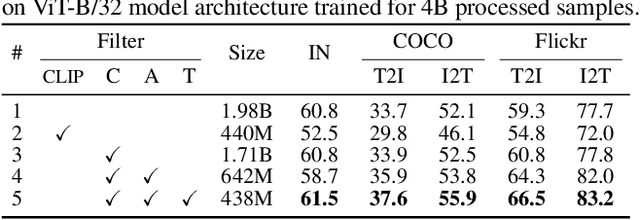
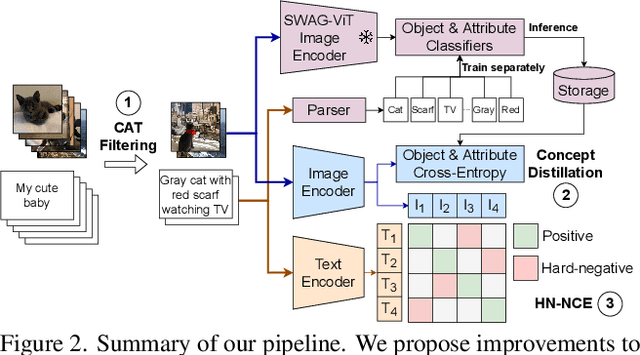
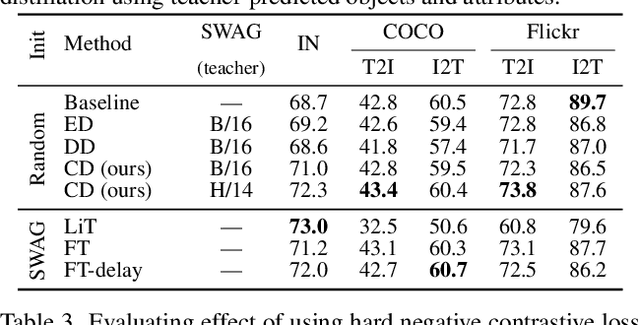
Abstract:Vision-language models trained with contrastive learning on large-scale noisy data are becoming increasingly popular for zero-shot recognition problems. In this paper we improve the following three aspects of the contrastive pre-training pipeline: dataset noise, model initialization and the training objective. First, we propose a straightforward filtering strategy titled Complexity, Action, and Text-spotting (CAT) that significantly reduces dataset size, while achieving improved performance across zero-shot vision-language tasks. Next, we propose an approach titled Concept Distillation to leverage strong unimodal representations for contrastive training that does not increase training complexity while outperforming prior work. Finally, we modify the traditional contrastive alignment objective, and propose an importance-sampling approach to up-sample the importance of hard-negatives without adding additional complexity. On an extensive zero-shot benchmark of 29 tasks, our Distilled and Hard-negative Training (DiHT) approach improves on 20 tasks compared to the baseline. Furthermore, for few-shot linear probing, we propose a novel approach that bridges the gap between zero-shot and few-shot performance, substantially improving over prior work. Models are available at https://github.com/facebookresearch/diht.
PACO: Parts and Attributes of Common Objects
Jan 04, 2023
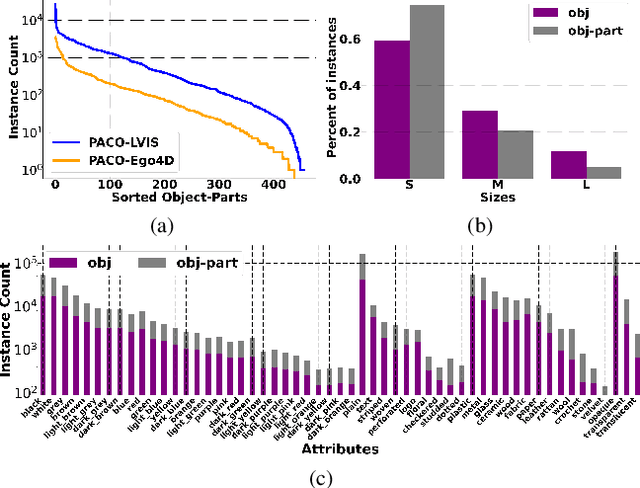
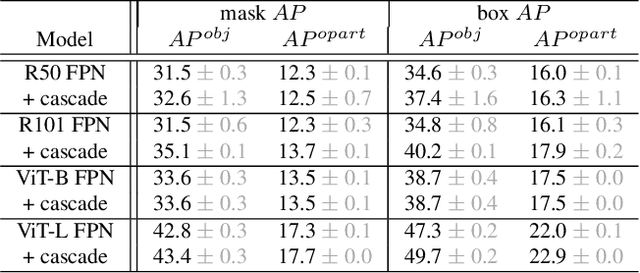

Abstract:Object models are gradually progressing from predicting just category labels to providing detailed descriptions of object instances. This motivates the need for large datasets which go beyond traditional object masks and provide richer annotations such as part masks and attributes. Hence, we introduce PACO: Parts and Attributes of Common Objects. It spans 75 object categories, 456 object-part categories and 55 attributes across image (LVIS) and video (Ego4D) datasets. We provide 641K part masks annotated across 260K object boxes, with roughly half of them exhaustively annotated with attributes as well. We design evaluation metrics and provide benchmark results for three tasks on the dataset: part mask segmentation, object and part attribute prediction and zero-shot instance detection. Dataset, models, and code are open-sourced at https://github.com/facebookresearch/paco.
Scalable Interpretability via Polynomials
Jun 08, 2022



Abstract:Generalized Additive Models (GAMs) have quickly become the leading choice for fully-interpretable machine learning. However, unlike uninterpretable methods such as DNNs, they lack expressive power and easy scalability, and are hence not a feasible alternative for real-world tasks. We present a new class of GAMs that use tensor rank decompositions of polynomials to learn powerful, {\em fully-interpretable} models. Our approach, titled Scalable Polynomial Additive Models (SPAM) is effortlessly scalable and models {\em all} higher-order feature interactions without a combinatorial parameter explosion. SPAM outperforms all current interpretable approaches, and matches DNN/XGBoost performance on a series of real-world benchmarks with up to hundreds of thousands of features. We demonstrate by human subject evaluations that SPAMs are demonstrably more interpretable in practice, and are hence an effortless replacement for DNNs for creating interpretable and high-performance systems suitable for large-scale machine learning. Source code is available at https://github.com/facebookresearch/nbm-spam.
Neural Basis Models for Interpretability
Jun 08, 2022



Abstract:Due to the widespread use of complex machine learning models in real-world applications, it is becoming critical to explain model predictions. However, these models are typically black-box deep neural networks, explained post-hoc via methods with known faithfulness limitations. Generalized Additive Models (GAMs) are an inherently interpretable class of models that address this limitation by learning a non-linear shape function for each feature separately, followed by a linear model on top. However, these models are typically difficult to train, require numerous parameters, and are difficult to scale. We propose an entirely new subfamily of GAMs that utilizes basis decomposition of shape functions. A small number of basis functions are shared among all features, and are learned jointly for a given task, thus making our model scale much better to large-scale data with high-dimensional features, especially when features are sparse. We propose an architecture denoted as the Neural Basis Model (NBM) which uses a single neural network to learn these bases. On a variety of tabular and image datasets, we demonstrate that for interpretable machine learning, NBMs are the state-of-the-art in accuracy, model size, and, throughput and can easily model all higher-order feature interactions. Source code is available at https://github.com/facebookresearch/nbm-spam.
Private and Byzantine-Proof Cooperative Decision-Making
May 27, 2022
Abstract:The cooperative bandit problem is a multi-agent decision problem involving a group of agents that interact simultaneously with a multi-armed bandit, while communicating over a network with delays. The central idea in this problem is to design algorithms that can efficiently leverage communication to obtain improvements over acting in isolation. In this paper, we investigate the stochastic bandit problem under two settings - (a) when the agents wish to make their communication private with respect to the action sequence, and (b) when the agents can be byzantine, i.e., they provide (stochastically) incorrect information. For both these problem settings, we provide upper-confidence bound algorithms that obtain optimal regret while being (a) differentially-private and (b) tolerant to byzantine agents. Our decentralized algorithms require no information about the network of connectivity between agents, making them scalable to large dynamic systems. We test our algorithms on a competitive benchmark of random graphs and demonstrate their superior performance with respect to existing robust algorithms. We hope that our work serves as an important step towards creating distributed decision-making systems that maintain privacy.
Adaptive Methods for Aggregated Domain Generalization
Dec 23, 2021



Abstract:Domain generalization involves learning a classifier from a heterogeneous collection of training sources such that it generalizes to data drawn from similar unknown target domains, with applications in large-scale learning and personalized inference. In many settings, privacy concerns prohibit obtaining domain labels for the training data samples, and instead only have an aggregated collection of training points. Existing approaches that utilize domain labels to create domain-invariant feature representations are inapplicable in this setting, requiring alternative approaches to learn generalizable classifiers. In this paper, we propose a domain-adaptive approach to this problem, which operates in two steps: (a) we cluster training data within a carefully chosen feature space to create pseudo-domains, and (b) using these pseudo-domains we learn a domain-adaptive classifier that makes predictions using information about both the input and the pseudo-domain it belongs to. Our approach achieves state-of-the-art performance on a variety of domain generalization benchmarks without using domain labels whatsoever. Furthermore, we provide novel theoretical guarantees on domain generalization using cluster information. Our approach is amenable to ensemble-based methods and provides substantial gains even on large-scale benchmark datasets. The code can be found at: https://github.com/xavierohan/AdaClust_DomainBed
 Add to Chrome
Add to Chrome Add to Firefox
Add to Firefox Add to Edge
Add to Edge